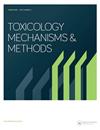甲基乙二醛对人红细胞、白细胞和血小板毒性的评价
IF 2.7
4区 医学
Q2 TOXICOLOGY
引用次数: 14
摘要
甲基乙二醛(Methylglyoxal, MG)是一种主要来源于葡萄糖降解途径的活性二羰基代谢物,在糖尿病(DM)的发病过程中起重要作用。MG与生物大分子(蛋白质、DNA和脂质)反应可诱导细胞毒性和细胞凋亡。在这里,人红细胞,白细胞和血小板急性暴露于浓度范围为0.025至10 mM的MG。随后测定红细胞溶血和渗透脆性、白细胞DNA损伤和细胞活力、血小板嘌呤能外核苷酸酶活性。白细胞的糖基化产物和红细胞和血小板的游离氨基的水平也被测量。MG引起细胞膜脆性、溶血和红细胞氨基耗竭。在白细胞中观察到DNA损伤,细胞活力丧失和糖基化产物水平升高。在血小板中,MG抑制ntpase、5′-核苷酸酶和腺苷脱氨酶(ADA)的活性,但不影响游离氨基水平。我们的发现为理解MG对不同血细胞的急性毒性机制提供了见解。本文章由计算机程序翻译,如有差异,请以英文原文为准。
Evaluation of methylglyoxal toxicity in human erythrocytes, leukocytes and platelets
Abstract Methylglyoxal (MG) is a reactive dicarbonyl metabolite originated mainly from glucose degradation pathway that plays an important role in the pathogenesis of diabetes mellitus (DM). Reactions of MG with biological macromolecules (proteins, DNA and lipids) can induce cytotoxicity and apoptosis. Here, human erythrocytes, leukocytes and platelets were acutely exposed to MG at concentration ranging from 0.025 to 10 mM. Afterwards, hemolysis and osmotic fragility in erythrocytes, DNA damage and cell viability in leukocytes, and the activity of purinergic ecto-nucleotidases in platelets were evaluated. The levels of glycated products from leukocytes and free amino groups from erythrocytes and platelets were also measured. MG caused fragility of membrane, hemolysis and depletion of amino groups in erythrocytes. DNA damage, loss of cell viability and increased levels of glycated products were observed in leukocytes. In platelets, MG inhibited the activity of enzymes NTPDase, 5′-nucleotidase and adenosine deaminase (ADA) without affecting the levels of free amino groups. Our findings provide insights for understanding the mechanisms involved in MG acute toxicity towards distinct blood cells.
求助全文
通过发布文献求助,成功后即可免费获取论文全文。
去求助
来源期刊

Toxicology Mechanisms and Methods
TOXICOLOGY-
自引率
3.10%
发文量
66
期刊介绍:
Toxicology Mechanisms and Methods is a peer-reviewed journal whose aim is twofold. Firstly, the journal contains original research on subjects dealing with the mechanisms by which foreign chemicals cause toxic tissue injury. Chemical substances of interest include industrial compounds, environmental pollutants, hazardous wastes, drugs, pesticides, and chemical warfare agents. The scope of the journal spans from molecular and cellular mechanisms of action to the consideration of mechanistic evidence in establishing regulatory policy.
Secondly, the journal addresses aspects of the development, validation, and application of new and existing laboratory methods, techniques, and equipment. A variety of research methods are discussed, including:
In vivo studies with standard and alternative species
In vitro studies and alternative methodologies
Molecular, biochemical, and cellular techniques
Pharmacokinetics and pharmacodynamics
Mathematical modeling and computer programs
Forensic analyses
Risk assessment
Data collection and analysis.
 求助内容:
求助内容: 应助结果提醒方式:
应助结果提醒方式:


